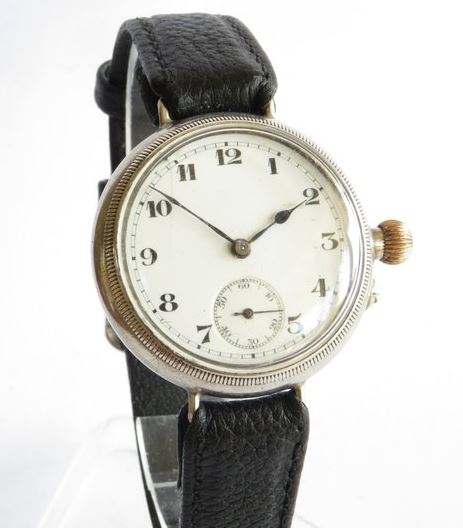Last updated on July 13, 2025
The First World War marked a turning point in how battles were fought and timed. For the first time, British generals directed operations from remote field headquarters. They could no longer see the front line. Communication across the wide battlefields was difficult and often delayed. Timing became essential for coordinating attacks and troop movements. Previously, soldiers advanced by watching neighbouring units or responding to visual signals. In WWI, such methods failed. Accurate timing was now the only way to ensure coordinated advances and avoid deadly delays. A delay of just 30 seconds could cost lives. Officers relied on their wristwatches to execute timed orders. Most trench watches had Swiss lever escapement movements, often jewelled and highly reliable. These could keep time to within a few seconds per day. Daily synchronisation ensured uniform timekeeping across units. For these reasons, the trench watch evolved and acquired some specific battlefield features.
Distinctive features of trench watches
Trench watches had specific features that set them apart from civilian wristwatches. Two of the most important were luminous dials and unbreakable crystals. The ideal trench watch combined these with a waterproof Borgel case. Officers’ watches needed to survive muddy, wet, and dusty conditions. A waterproof case offered vital protection. While Borgel cases were rarely advertised by name, their unique features made them popular among soldiers heading to the front (Borgel and Taubert at WahaWatches). Trench watches had to work in total darkness. Luminous dials made it possible to check the time without light. This was essential during night operations, when showing a torch or lamp could attract enemy fire.
Unbreakable crystals
Many trench watches used “unbreakable” crystals made from celluloid, an early plastic that resisted shattering. Earlier wristwatches used mineral glass crystals, which broke easily on impact. Celluloid offered flexibility and safety, making it better suited for battlefield conditions. Acrylic crystals, such as Perspex, became common only later, in the 1930s. These were safer than celluloid but unavailable during the First World War. The use of celluloid reduced injury risk from broken glass and protected watch mechanisms from moisture and dust.
Unbreakable watch crystals were introduced during the First World War. Patents were filed in both Switzerland and America around 1915. The first versions were made by cutting flat discs from celluloid, an early plastic known for its flexibility and impact resistance. However, flat plastic sheets lacked dimensional stability. They could shrink in cold weather or over time, risking them falling out. To solve this, manufacturers fitted the crystal into the bezel under tension, ensuring a secure and lasting fit. They cut the crystal slightly oversized, with a bevelled edge. A press then shaped it into a shallow dome. This dome allowed the crystal to fit inside the bezel. When released, the tension held it tightly in place. The method worked because the plastic tried to flatten, locking its edge into a groove inside the bezel ring (First World War Trench Watches at Vintage Watchstraps).
Luminous paint
Luminous dials and hands used radium-based paint. This mixed radium salts with zinc sulphide and a binder. Radium’s radiation caused zinc sulphide to glow constantly without needing external light. The glow lasted only a few years because zinc sulphide degraded. The paint would then have to be reapplied. Despite the luminescence fading, the radium itself remained radioactive for thousands of years. Even today, trench watches from the First World War, with the paint intact, still emit measurable radiation (Luminous Dials at Hodinkee).
During the war, few understood radium’s dangers. Workers who applied radium paint, like the “Radium Girls,” suffered serious radiation poisoning. Collectors now handle these watches carefully and often check them with Geiger counters. In many cases, the luminous paint has been removed over the years as the dangers of radium became well known.
Evolution of the wristwatch in war
Before the war, wristwatches were rare and mainly worn by women. Some pre-war pocket watches were converted for military use. However, these civilian watches lacked luminous dials and water protection, which were key for frontline use. Officers usually bought purpose-built wristwatches with these features. Other ranks might use less suitable alternatives.
Manufacturers met demand by modifying small pocket watches. They added fixed wire lugs to attach leather straps. However, pocket watches had crowns at 12 o’clock, which was awkward for wrist wear. Converted watches often show unusual dial angles. Savonnette (hunter) movements had crowns at 3 o’clock and seconds at 6. When placed in wristwatch cases with wire lugs, they offered a better layout. These watches were not conversions but new assemblies from existing parts. They represent the first true wristwatches designed for men (The Trench Watch – A Brief History at Vintage Watch Specialist).
As the war progressed, wristwatches gained more battlefield-specific features. Luminous dials, unbreakable crystals, and waterproof cases became standard for military use. These watches were widely advertised as suitable for military and naval service.
Summary
Luminous hands and numerals allowed timekeeping in total darkness. This was vital for timing raids and attacks. Unbreakable crystals protected dials during combat. Resistance to dust and water kept the watches working in trenches. Displaying seconds was critical for synchronising operations precisely.
Trench watches evolved from practical needs. They combined function, innovation, and durability. These features made them a lasting legacy of wartime watchmaking and influenced the development of modern wristwatches.

